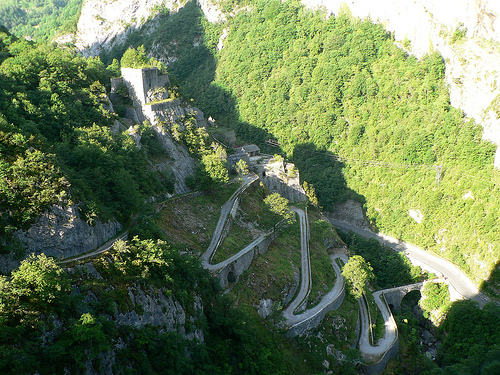

Location: Bearn, French Pyrenees Map
Constructed: 1842- 1870
Altitude: 699 meters
Capacity: 400
Fort du Portalet is located in the French province of Bearn in the French Pyrenees. It's construction began on the 22nd of July, 1842 by the orders of the French king Louis Philippe I and was completed after his abdication.
The fort is located at an altitude of between 700 and
800 m. It is located entirely in the commune of Etsaut, near the
administrative limit of Urdos, and on the right bank of the Gave d'Aspe,
at the confluence with the Sescoué torrent, on a steep west-northwest
facing slope. It is reached by a bridge spanning the gave and then a
winding road. This bridge is located about three kilometers upstream
from the center of Etsaut, two kilometers downstream from the center of
Urdos and sixteen kilometers from the Col du Somport.
In the
lower part of the fort, there are a barracks and an officers' pavilion,
on two levels. Above is built a small fort composed of three bastions
armed with batteries for cannons, the fort included ten3. These bastions
protect the Rouglan plateau path and the Mâture path. Galleries carved
into the rock, crenellated or with loopholes, cover the road descending
from Urdos and the Col du Somport.
Construction
On July 22, 1842, the construction of the fort
began, on the instructions of King Louis-Philippe. It then replaced
the old post located on the edge of the imperial road, 100 m to the
north. At the time, it was imperative to build fortifications in
order to control the road to the Col du Somport in the event of war
with the Spanish neighbour. The works were carried out in a
difficult environment (rocks, climate, surroundings of the Gave
d'Aspe, etc.) and lasted until 1870. The fort took the name of the
old medieval tollbooth in the Aspe valley, the Portalet which was
located 100 meters below.
From 1871 to 1945
The fort was
designed to house 400 men, capable of withstanding a siege of at
least a week. It was occupied from 1871 to 1925 by the 18th infantry
regiment of Pau.
On this date, it was abandoned by the army
and rented to a summer camp until 1939.
Under the Vichy
regime, it served as a political prison for personalities of the
Third Republic (Daladier, Reynaud, Blum, Mandel, General Gamelin,
etc.) from 1941 to 1943 and who, after the German occupation of the
free zone , are sent to Germany. The fort will then house a German
garrison. It was taken over by the guerrillas in 1944. Guarded by a
platoon of mobile guards, Marshal Pétain was detained there for 3
months from the day after his trial on August 15, 1945 until his
transfer to the fortress on the island of Yeu on November 16, 1945.
From 1945 to today
After the war, the 18th infantry regiment
occupied it again until 1952, then the fort was officially
demilitarized by the Ministry of Defense in 1962 and it was bought,
during an auction, by an individual in 1966 for 171,000 francs but
the real estate projects of this one do not see the light of day.
Nothing was done for its maintenance and, in a certain state of
neglect, it was bought by the community of communes of the Vallée
d'Aspe in 1999. The access path was first restored in order to
secure its use. In 2006, work to remove weedy vegetation is in
progress, as well as work to restore the roofs and terraces in order
to protect the site from water infiltration. Subsequently, other
restoration and security works will take place depending on the
release of funding, in order to open the site to visitors.
It
was classified as a historic monument on November 30, 2005 with the
following motivation: "presents from the point of view of history
and art a public interest because it is one of the most successful
defenses of all the fortifications of the Pyrenees, which
constitutes an important milestone in the history of the
fortifications of the 19th century and fits in an exceptional way
into its landscape environment".
The tourist office and the eco-museum of the Aspe valley organize
guided tours of Fort du Portalet. These visits are available, by
reservation, from the tourist office.
Since June 2021, a
Himalayan footbridge has allowed pedestrians to cross from the
chemin de la mâture to Fort du Portalet.
In 2015, Fort Portalet was the site of a reintegration experiment, enabling six prisoners to acquire the professional skills of mason.